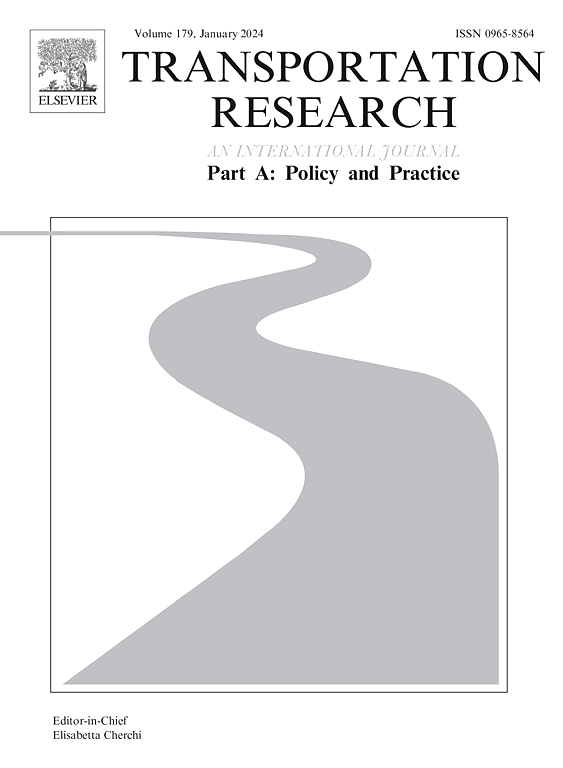感知的可达性和交通公平:满意度是否意味着感知到的机会充足?
IF 6.3
1区 工程技术
Q1 ECONOMICS
Transportation Research Part A-Policy and Practice
Pub Date : 2025-05-28
DOI:10.1016/j.tra.2025.104497
引用次数: 0
摘要
在空间可达性不平等的规范性评价中,个体可达性满意度和可达性机会感知充分性是可达性感知的不同维度。满意度评估是以结果为基础的,并通过捕捉当前达到预期活动的经验的差异,为可及性的分配公平性评估提供信息。是否有足够的选择是基于机会的评估,并与程序公正有关,反映了对形成无障碍分配机制的公平性的判断。在荷兰进行的一项调查中,大多数人都报告了很高的满意度和自觉性。然而,出现了明显的差异,特别是在农村地区,许多人对无障碍表示满意,但也对机会是否充足表示关切。就政策实践而言,重要的是要认识到,与个人从可及性和感知到的充分机会中获益有关的目标在更广泛的社会和环境政策议程中并没有内在联系,也可能相互冲突。认识到解释可及性满意度和感知充分性之间差异的机制,有助于决策者在可及性规划中明确司法优先事项,平衡基于机会和基于结果的战略。本文章由计算机程序翻译,如有差异,请以英文原文为准。
Perceived accessibility and transport equity: Does satisfaction imply perceived sufficiency of opportunities?
This paper demonstrates that individual satisfaction with accessibility and perceived sufficiency of opportunities represent distinct dimensions of perceived accessibility in the normative evaluation of spatial accessibility inequalities. Satisfaction assessments are outcome-based and inform evaluations of the distributive justice of accessibility by capturing differences in current experiences of reaching desired activities. Perceptions of having sufficient options are opportunity-based assessments and relate to procedural justice by reflecting judgments on the fairness of mechanisms shaping accessibility distributions. In a survey conducted in the Netherlands, most individuals report both high satisfaction and perceived sufficiency. However, notable discrepancies emerge, particularly in rural areas, where many express satisfaction with accessibility but also concerns about the sufficiency of opportunities. For policy practice, it is important to acknowledge that goals related to individual benefits from accessibility and perceived sufficiency of opportunities are not inherently linked and potentially conflicting within broader social and environmental policy agendas. Recognizing the mechanisms explaining differences between satisfaction with accessibility and perceived sufficiency can help policymakers clarify justice priorities and balance opportunity-based and outcome-based strategies in accessibility planning.
求助全文
通过发布文献求助,成功后即可免费获取论文全文。
去求助
来源期刊
CiteScore
13.20
自引率
7.80%
发文量
257
审稿时长
9.8 months
期刊介绍:
Transportation Research: Part A contains papers of general interest in all passenger and freight transportation modes: policy analysis, formulation and evaluation; planning; interaction with the political, socioeconomic and physical environment; design, management and evaluation of transportation systems. Topics are approached from any discipline or perspective: economics, engineering, sociology, psychology, etc. Case studies, survey and expository papers are included, as are articles which contribute to unification of the field, or to an understanding of the comparative aspects of different systems. Papers which assess the scope for technological innovation within a social or political framework are also published. The journal is international, and places equal emphasis on the problems of industrialized and non-industrialized regions.
Part A''s aims and scope are complementary to Transportation Research Part B: Methodological, Part C: Emerging Technologies and Part D: Transport and Environment. Part E: Logistics and Transportation Review. Part F: Traffic Psychology and Behaviour. The complete set forms the most cohesive and comprehensive reference of current research in transportation science.

 求助内容:
求助内容: 应助结果提醒方式:
应助结果提醒方式:


